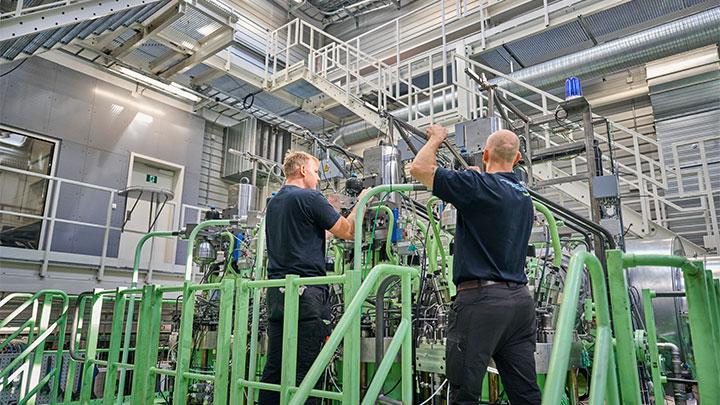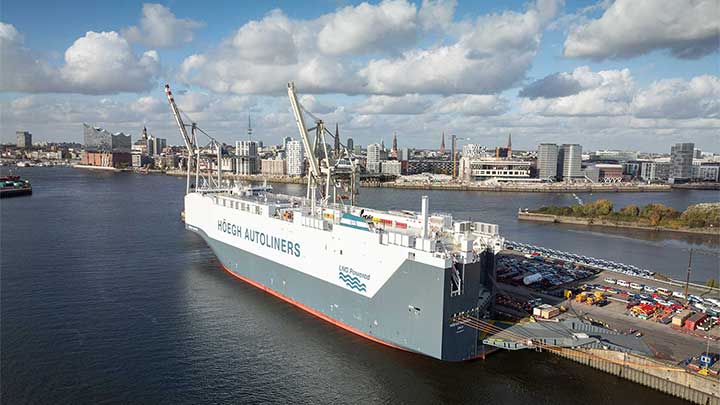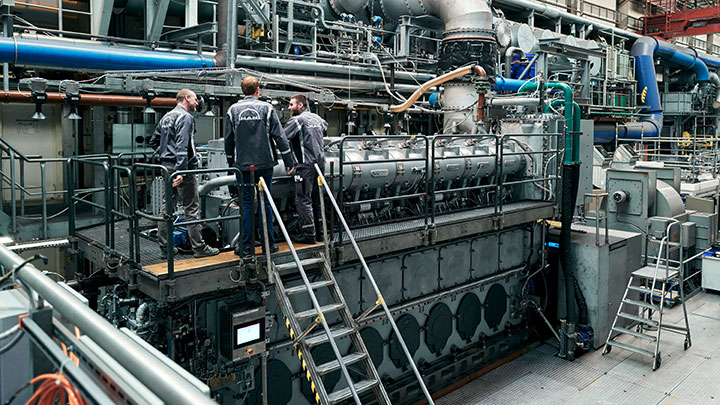Alternative fuel expert Rasmus Bach Nielsen reveals how shipping can unlock the potential of e-fuels.
Can the shipping industry achieve deep decarbonization? “It’s not a technology issue,” says Rasmus Bach Nielsen. As Global Head of Fuel Decarbonization at Trafigura Group, one of the leading suppliers of commodities, Bach Nielsen is driving the company’s goal to reduce operational emissions by over 50 percent by 2032. Discover speaks to him about large-scale hydrogen projects, the development of a two-stroke ammonia engine, and the single most important aspect for shipping to reach to net-zero emissions.
By Niels Anner.
Discover: The Trafigura Group is co-sponsoring the development of MAN Energy Solutions ammonia-fuelled engine for maritime vessels. What prompted the involvement in the project?
Rasmus Bach Nielsen: We supported a study back in 2019 to 2020 with PhD professors from Texas A&M which concluded that blue and green methanol and ammonia would be the transport fuels of the future. And with that knowledge we made an assessment: Because we use a significant amount of third-party tonnage, if the industry doesn’t decarbonize then we can’t decarbonize. And if there’s two fuels of the future and only engines available for methanol…Well, what we did at the time, which was probably way ahead of anybody else, was to go to MAN Energy Solutions and say: “We need you to develop the ammonia engine.” This is completely different from what we’ve done before in terms of participating in bringing new technology forward, co-funding the technology development costs for the ammonia engine, mitigating financial risk in order for the industry to decarbonize faster.
It’s blue and green methanol and ammonia that are the transport fuels of the future.
So, ultimately the only way to decarbonize the shipping industry is to shift to low-carbon fuels. Are we only talking about methanol and ammonia? What about LNG?
The (International Maritime Organization (IMO) has been using tank-to-wake emission measurements, that’s been the baseline – which we believe doesn’t give an appropriate picture of the emissions from the different fuels. With a full lifecycle assessment – and with the current technology knowledge that we have – LNG delivers much lower CO2 savings compared to methanol and ammonia. So, in our view, it’s blue and green methanol and ammonia that are the transport fuels of the future for long-haul shipping. For domestic ferry business, domestic shipping and shorter routes – there’s a chance it could be something else.

Building-up a green fuels economy
Okay, so what’s currently standing in the way of methanol and ammonia being widely used? Is it technology? Is it production? Or is it cost compared to fossil fuels?
Methanol and ammonia production has been going on for years and years – and the ammonia engine is coming. So, it’s not a technology issue. But it is a price and availability issue. The challenge today is that green fuels are significantly more expensive than fossil fuels, making it difficult for project owners who want to produce green fuels. When investement decisions need to be made, it’s hard to commit many millions of dollars without having the demand there too.
We have our own large-scale hydrogen project in Denmark that we’re maturing through H2 Energy Esbjerg, of which we are the majority owners. By Christmas last year we had invested about 200 million Danish Krones, and we still don’t know if we’ll make the final investment decision in this project later this year as it’s dependent on a hydrogen pipeline connection also to Germany. And here we’ll probably be selling the hydrogen in pure form to industrial Europe, not to the shipping industry, because we haven’t yet seen the offtaker willing to pay the price for us to produce methanol or ammonia, which would make it a positive financial business case. Now, there are a few projects where this can and will make sense, but we’re talking about scale. And to transition the shipping industry at scale with low-emission fuels, we need the market to be open.

The IMO revised greenhouse gas emissions strategy
Last year, shortly before the International Maritime Organization (IMO) revised its strategy on greenhouse gas emissions, you co-authored a white paper with Margaux Moore on a greener future for shipping, in which you stated that there is a current window of opportunity. Has the IMO taken advantage of it?
The revised strategy was positive and better than many expected at the time, which is always a good step. But is it enough compared to what we need? Then the answer is no. However, the IMO follows a process and it takes time – and we all have to accep that. What is positive, though, is that there seems to be a direction towards introducing a levy on carbon intensive marine fuels in 2025, and this is what we need. This is ultimately the most important aspect. Once we have a significant carbon pricing penalty for fossil fuels, that’s when the demand for green fuels will start to kick in for real. The second important aspect is having full lifecyle fuel standards.
Without regulation, I don’t think we can realistically expect deep decarbonization of shipping. It’s unfortunate that the market needs politicians to make this kind of legislation, but one thing we should not forget: Today, we don’t pay when we pollute. So, is that fair or not? The reality is, that’s probably not fair.

Carbon-pricing to drive decarbonization
So, it’s not possible to decarbonize without a price on carbon?
Deep decarbonization won’t be possible. There are a lot of processes now where ship owners and operators are optimizing as much as they can – that’s a very positive thing and shouldn’t be underestimated. And the value of these optimizations will become even bigger when we have carbon penalties.
You mentioned there might be a carbon levy decision by 2025. Is that realistic?
It can happen. Obviously, it’s clear to everyone – all the reports that one reads – we’re polluting more than the earth can absorb. We’re all going to own the problems unless we manage to find alternative solutions.
Which is why we’re asking to be regulated in our own core trading market, i.e., oil – it’s a necessity for shipping to transition. It’s actually equal for all. Whether you have two ships or ten ships, you can still buy a new, green ship. It really comes down to future skill sets, being agile and moving with new market requirements. It’s an opportunity more than a threat.
At the moment we're still waiting for concrete short-term measures from the IMO. What would you like to see?
It would be fantastic if 5 percent of the global fleet was powered on low- or zero-emission fuels by 2030. So, depending on which fuel, it would probably mean the global fleet would need to burn 28 to 30 million tons of ammonia or methanol. Supplying the fuel will be a difficult task, but not impossible. We’ll need the strongest possible signals from the forthcoming IMO meeting, because green fuel producers need to see that something is happening. If we wait until a carbon levy is decided on in 2025 (assuming it is 2025), then it probably isn’t realistic to get the green fuels we need in time.
So, it’s possible, and there are a lot of large corporations – we’re one of them – moneymaking significant invements to mature green fuel projects now. And if we do have carbon pricing in 2025, I think we’ll have a kind of hockey stick development of the fuel supply from 2030 to 2033 and decarbonizing shipping has a chance to grow much faster.
About the author
Niels Anner is an independent journalist based in Copenhagen, who writes on business, science, technology and society in Northern Europe.
Trafigura’s clean future for shipping
Founded in 1993, Trafigura is a leading supplier of commodities and one of the world’s largest charterers of vessels, responsible for more than 5,000 voyages each year with 30 owned vessels and almost 360 ships under management. The company is committed to reducing the carbon footprint of their shipping operations by 25 percent by 2030 (compared to the 2019 IMO baseline) with a number of initiatives to improve efficiency such as silicon hull paint, heat recovery systems and propeller polishing. Currently, Trafigura operates shipping vessels capable of running on all available alternative fuels, including LNG, LPG, ethane, methanol and biofuels. In addition, they have set a target to have at least six zero-emission green ammonia-fueled vessels in its fleet by 2030 if this becomes technically feasible.
Explore more topics
-

Hoegh - LNG-powered car carrier
With its first LNG-powered car carrier, Höegh Autoliners is taking a big step towards its target of net-zero by 2040. The centerpiece of the vessel is a MAN Energy Solutions MAN B&W ME-GI dual-fuel engine.
-

Maersk Halifax Retrofit
The world’s first methanol retrofit of the Very Large Container Vessel Maersk Halifax opens the doors for green fuels.
-

Methanol dual fuel retrofit
Engineers are now testing a retrofit for four-stroke ship engines that will enable ferry and cruise ship operators to meet the growing requirements on emission reduction with green methanol.
